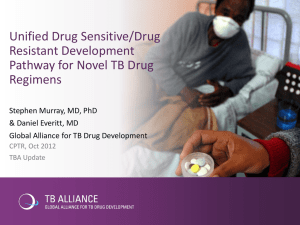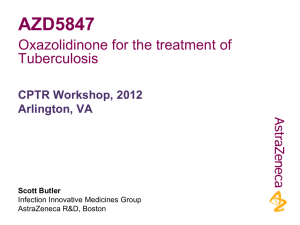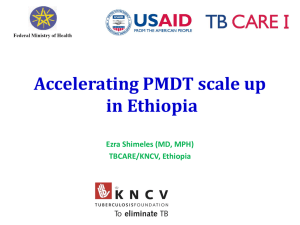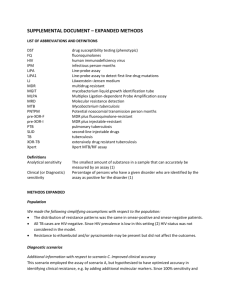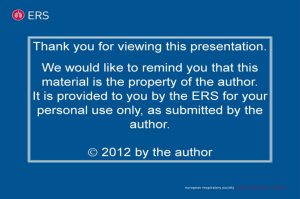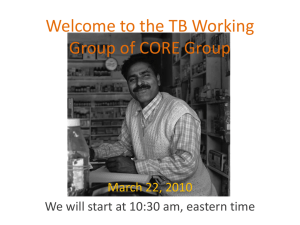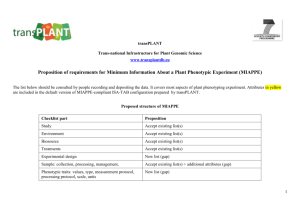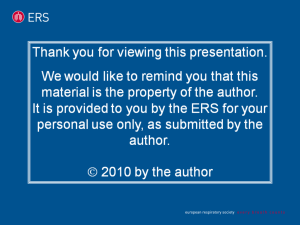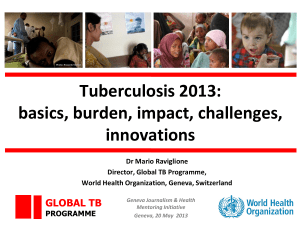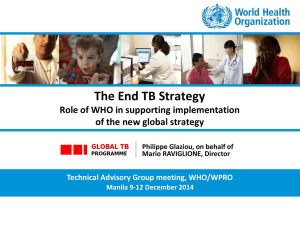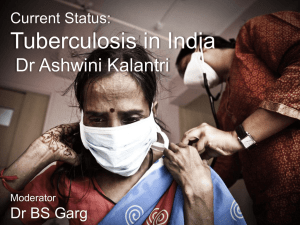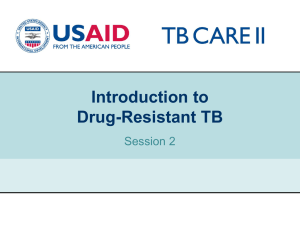the Presentation of ICS
advertisement
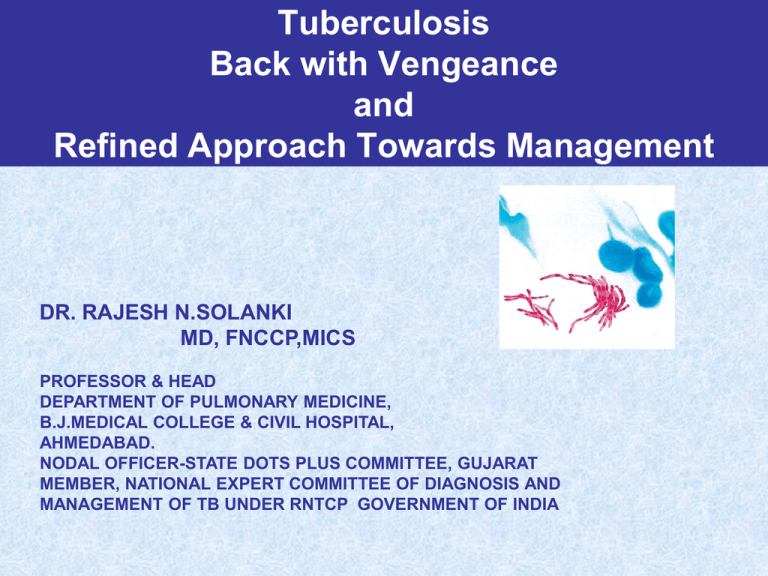
Tuberculosis Back with Vengeance and Refined Approach Towards Management DR. RAJESH N.SOLANKI MD, FNCCP,MICS PROFESSOR & HEAD DEPARTMENT OF PULMONARY MEDICINE, B.J.MEDICAL COLLEGE & CIVIL HOSPITAL, AHMEDABAD. NODAL OFFICER-STATE DOTS PLUS COMMITTEE, GUJARAT MEMBER, NATIONAL EXPERT COMMITTEE OF DIAGNOSIS AND MANAGEMENT OF TB UNDER RNTCP GOVERNMENT OF INDIA TB in Ancient Age • There have been references to this ancient disease in the VEDAS and it was called RAJAYAKSHMA (meaning wasting disease). • Hippocrates called the disease PTHISIS a greek word which meant “to consume” “to spit” and “to waste away”. • The word tuberculosis is a derivative of the latin word “tubercula” which means a small lump. TB in Ancient Age • Oliver holmes referred to the disease as "white plague" • “lung cough” & “lung fever” has been used in ancient Chinese literature. • Evidence of TB lesions of bone have been found in ancient mummies dating back to 3400 B.C. • Middle ages, records of healing touch of monarchs was being used to treat “scrofula” • By around 1629, death certificates in London specified the disease as “consumption” a leading cause of death. • By this time the contagious nature of TB was strongly believed. Though, there were people who contested this opinion. Discovery of Mycobacteria Mycobacterium tuberculosis is a pathogenic bacterial species in the family Mycobacteriaceae and the causative agent of most cases of tuberculosis. First discovered in 1882 by Robert Koch, M. tuberculosis has an unusual, waxy coating on its cell surface (primarily due to the presence of mycolic acid), which makes the cells impervious to Gram staining The Ziehl-Neelsen stain, or acid-fast stain, is used instead. TB Management Early 19th Century Pre-antibiotic era: before 1940s (e.g., cod liver oils, bed rest, fresh air) Era of conventional chemotherapy Dr P V Benjamin FATHER OF ANTI-TB MOVEMENT IN INDIA TB Chemotherapy : The Effective TB Control • Drugs used to treat TB: (a) Front-line Drugs: isoniazid (INH) rifampicin (RMP), pyrazinamide (PZA), streptomycin, ethambutol. 1952 1946 Isoniazid PAS 1944 Streptomycin (b) Second-line Drugs: PAS, kanamycin, cycloserine, ethionamide, thiacetazone, ciprofloxacin/ofloxacin, rifapentine, amikacin, viomycin, capreomycin. 1963 Rifampicin Drug action on TB bacillary population INH RIF RIF Extra-cellular rapidly multiplying 108 SM EMB PAS Dormant No drugs Extra-cellular slowly multiplying <105 PZA Intra- and extracellular, acidic environment <105 Intensive Phase • • • • • Aims for a rapid killing of bacilli A state of non-infectiousness within 2/52 Quick relief of symptoms Smear negativity by 2/12 Prevent development of drug resistance multi-drug regimens and DOT Continuation Phase • Aims to eliminate remaining bacilli • Killing of “persisters” prevents relapses • Multi-drug regimens and DOT necessary (unless R not used) even though risk of emergence of drug resistance is less as fewer bacilli remain Tuberculosis Management • • • • • • • • Standard/Conventional Chemotherapy Supervised Chemotherapy Short course Chemotherapy RNTCP based on DOTS Directly Observed Treatment Short course Stop TB Strategy DOTS Plus strategy and ISTC STCI The slow road to microscopy diagnosis of TB “The starting-point in the fight against all contagious diseases is the obligation to report because without this most cases of the disease remain unknown.” Nobel lecture by Robert Koch, 1905 A new POC TB Diagnostic tool could save up to 400,000 lives per year. Nature Estimated number of MDR-TB Cases, 2013 More tha 50% of all cases are in Russian 3 countries Federation 41,000 (15% of global MDR burden) China 54,000 India 3.5 % new cases 21 % previously treated cases * among notified TB cases (20% of global MDR burden) 62,000 (22% of global MDR burden) Countries that had reported at least one XDR-TB case - 2013 92 countries 9 % MDR TB cases have XDR TB 17 %MDR-TB cases with additional resistance to fluoroquinolones Is MDR-TB a real threat in India? State Proportion of MDR amongst new TB cases Proportion of MDR amongst re-treatment TB cases Gujarat 2.4% 17.4% Maharashtra 2.7% 14% Andhra Pradesh 1.8% 11.8% National DRS – (7 sites) co-ord. by AIIMS, patients of Medical colleges, DTC & PHC 7 sites (unpublished) 7.8% 29.8% Community survey of TB prevalence- MDR out of TB Gujarat 7.8% 17.1% >30% of Tuberculosis cases amongst the contacts of MDR TB are found to be MDR-TB Primary transmission ? Is XDR TB a real threat in India? High XDR / pre-XDR levels out of XDR suspects undergoing Second-line Drug Susceptibility Testing at NRLs Source: National TB Institute, Bangalore The case of Mumbai and the “TDR-TB outbreak” – Jan 2012 March 2012 - WHO convened 40 experts meet • Such cases pose a formidable challenge to clinicians and public health authorities • No reliable definition beyond XDR-TB • Improvements in the accuracy of drug susceptibility testing to certain drugs • Release of innovative new drugs will, however, change this position in future. • India turned this crisis into opportunities for improvements in Mumbai and country wide Udwadia ZF, Amale RA, Ajbani KK, Rodrigues C. Totally drug-resistant tuberculosis in India. Clin Infect Dis. 2012 Feb 15;54(4):579–81. Cumulative data up to June 2014 MDRTB Suspects tested MDRTB Put on Rx XDR TB Put on Treatment 447670 53883 1021 122 DR-TB centres and 50 linked DR-TB centres (district level) DIAGNOSIS OF TB: Drug Resistance TB MONO & POLY RR TB DR TB MDR TB MDR TB Plus XDR TB XDR TB Plus NTM ?? Role of the Laboratory • Ideally all TB cases should need C & DST • Genotyping or Phenotyping • Quality Assurance Lab. • Clinically Correlation is Mandatory • No Trial ATT • Treatment Adherence • Problems with NTM/Atypical Mycobacteria MTB Diagnostic Aspects: Drug Resistance TB PHENOTYPING SOLID (L J MEDIUM) LIQUID (MGIT 960) • • • • VIABLE BACILLI BSL II & III LABOURIOUS PROCESS TIME CONSUMING GENOTYPING/ MOLECULAR LPA CBNAAT (GENEXPERT) • • • • RAPID TEST DNA BASED BSL – I FACILITY 95 % CONCORDANSE MTB DRplus: Line probe assay • Based on PCR line probes • Identifies M.Tb and detects Rif & INH resistance in a day Integrated automated NAAT: Cepheid Xpert MTB/RIF Assay Major advantages in workflow fully automated with 1-step external sample preparation time-to-result 2 h (walk away test) throughput: up to 4 tests / module no bio-safety cabinet closed system (no contamination risk) Performance specific for MTB sensitivity similar to solid culture detection of rif-resistance via rpoB gene cartridge MTB Management of Tuberculosis Grouping of Anti TB Agents Grouping Drugs Group 1: First-line oral anti-TB agents Isoniazid (H); Rifampicin (R); Ethambutol (E); Pirazinamide (Z) Group 2: Injectable anti-TB agents Streptomycin (S); Kanamycin (Km); Amikacin (Am); Capreomycin (Cm); Viomycin (Vm). Group 3: Flouroquinolones Ciprofloxacin (Cfx); Ofloxacin (Ofx); Levofloxacin (Lvx); Moxifloxacin (Mfx); Gatifloxacin (Gfx) Group 4: Oral second-line anti-TB agents Ethionamide (Eto); Prothionamide (Pto); Cycloserine (Cs); Terizadone (Trd); para-aminosalycilic acid (PAS); Group 5: Agents with Unclear role in Treatment of DR TB Clofazimine(cfz); Clarithromycin(Clr) Amoxacillin/Clavulanate(amx/clv); Thioacetazone(Thz); High Dose INH; Imipenem/Cilastatin(Ipm/Cln); Linezolide(lzd); RNTCP Category IV Regimen RNTCP is using a Standardised Treatment Regimen (STR) for the treatment of MDR-TB cases under the programme. REGIMEN: - 6 (9) Km Lvx Eto Cs Z E / - 18 Lvx Eto Cs E • All drugs to be given daily under direct observation with Inj KM. • On Sundays, Inj KM is omitted and oral drugs are given un-observed • Na PAS is a reserve drug to be used instead on any one drug In patients care (DR TB Center) • Airborne Infection control Measures • Individual rooms • Well-spaced wards DR-TB – Ambulatory Care • After completion of in patient Care, patient has to receive Ambulatory daily DOT services • Hence need to create DR-TB DOT provider network for MDR-TB patients • Follow-up smear and culture examinations at months 3, 4, 5, 6, 7, 9, 12, 15, 18, 21, and 24 • Outcome will be based on culture results • Treatment outcome report submitted 31-33 months after patients in the respective cohort registered for treatment Treatment outcomes of patients diagnosed with MDR-TB, 2007-11 cohorts Among MDR cases starting treatment in 2010, the 75% treatment success threshold was achieved by 34 of the 107 countries RNTCP Category V Regimen RNTCP is using a Standardised Treatment Regimen (STR) for the treatment of XDR-TB cases under the programme by daily DOT. REGIMEN: 6 (12) Cm Mfx PAS, High Dose H, Cfz, Lzd,Amx-Clv./ 18 Mfx PAS, High Dose H, Cfz, Lzd,Amx-Clv Clr. & TZN are substitute drugs for any one drug in case of intolerance or ADRs Regimen for XDR TB Moxifloxacin (Mfx) High dose INH (High dose-H) Clofazimine (Cfz) Linezolid (Lzd) Amoxyclav(Amx/Clv) Pyridoxine Inj. Capreomycin (Cm) PAS Type-A Type-B Treatment outcome of XDR-TB, Global Total 1,269 XDR TB patients from 40 countries for whom outcomes were reported in 2013. Palliative Care MDR TB: Cure rate 40%, Death: 26%, Failure 10%, Default 24%* Treatment causes frequent and severe side effects Palliative care for M/XDR TB • Should begin at the time of the diagnosis • Is not limited to – Patients who do not respond to active treatment – Patients who no longer qualify for active treatment • Includes but is not limited to «end of life care» Complications and Sequelae • • • • • • • • Advanced lung diseases Dyspnea, cachexia Chronic obstructive lung diseases Unhealed cavities in lungs Recurrent hemoptysis Bronchiectasis with recurrent infections Partial or complete lung collapse Thoracic empyema….etc. Psychosocial issues: Patients and Families • • • • • • Anxiety, depression and Suicidal ideation Fear of dying Stigma, discrimination and social isolation Adverse drug reactions Adherence issues Lack of support - social, financial, psychological • Loss of employment affecting livelihood • Alcohol abuse • Co-morbid conditions Psychosocial support Counsel patient & family Meditation, Tranquilizers Patient peer groups Become a Provider Vocational Rehabilitation Vocational Training Skill development Microfinancing Physiotherapy Pulmonary Rehabilitation Nutrition Appropriate Diet, Maintenance of BMI within normal limits Breathing Exercises Yoga, recreation Engage in light works Surgical intervention Decortication Lobectomy PC Window RNTCP Challenges • Diagnosis reliant on age old low sensitivity tools and case finding strategies • Multi drug resistance – HIV/AIDS infection and other comorbid conditions • Barriers to DOTS – Practical challenges in rural conditions – patients cultural beliefs – human rights • Insufficient infrastructure – Lack of motivated personnel • No regulation over private providers • Need for stronger national policy • Funding gaps REFINED APPROACH Newer Diagnostics • CXR (Digital; Computer Aided Detection for TB) Newer Diagnostics • Sputum smear microscopy (LED FM) • Automated staining tool and slide processors (RAL STAINER) • Automated slide reader (TBDx system) • Automated slide reader Newer Diagnostics • Fluorescence in situ hybridization (FISH) • Liquid culture plateforms (MGIT 960, BacT/Alert 3D 120, VersaTREK 528) Case finding strategy • Proactive case finding approach Widespread awareness with community engagement in identifying presumptive TB case and referring them to diagnostic centres Community mobilization with support of local selfgovernment Active TB case finding among high risk groups • Urban slum, PLHIV, DM, malnutrition, high risk health care settings, patient contacts, migrants Management of TB: First Line therapy - Intensive Phase: 3 HERZ ( Extension of 1 month if require) Continuous Phase: 6 HER RIETT Panel (Redefining Indian Expertise based Tuberculosis Treatment 2006) - Initial phase : Two months of HERZ & Continuation phase consist of three HER at least four months. The duration of continuation phase may be extended by three to six months in special situations like Bone & Joint TB, Spinal TB with neurological involvement and neuro-tuberculosis. (Standard of TB Care in India WHO 2014) Management of TB: First Line therapy All patients should be given daily regimen under direct observation. However, the country programme may consider daily or intermittent regimen for treatment of TB depending on the available resources and operational considerations as both are effective provided all doses are directly observed All paediatric TB patients and HIV associated TB patients should be given daily regimen under direct observation. (Standard of TB Care in India WHO 2014) Management of Tuberculosis • Patients with mono-resistant TB and patients with poly-resistant TB other than MDR-TB. • Mono-resistance refers to resistance to a single first-line drug, (without Rifampicin) • Poly-resistance refers to resistance to two or more first-line drugs. (without Rifampicin) Suggested regimen for Mono & Poly Drug Resistance TB (WHO 2008) Pattern of Suggested drug resistant regimen Minimum duration (months) For extensive disease H ( S) RZE 6-9 FQ strengthen regimen HZ REFQ 9-12 Longer duration of treatment HE RZFQ 9-12 Longer duration of treatment HEZ ( S) RFQ+oral 18 SLD+inj for 2-3 months Longer duration (6 months) of injectables DRUG RESISTANCE PATTERN Monodrug resistant TB INH Resistance- By LPA S, H, E or Z monoresistance by Liquid Culture Basic regimen- 5 drugs Inj SLD + FQ + Rifampicin+ 2 out of the remaining three first line drugs to which the patient is sensitive (from H,E & Z) to make a total of 5 effective drugs given DAILY Polydrug resistant TB Basic regimenInj SLD + FQ + Rifampicin + any 2 FLD (from H,E,Z). If 2 FLDs cannot be used, select from WHO Group 4 drugs -Ethionamide, Cycloserine or PAS to make a total of 5 given DAILY The regimens for every DR TB Patient will be decided by the DR TB Centre committee and the patient will be sent back to the DTO for further management National Workshop on Drug Susceptibility Testing (DST) Guided Treatment for Drug Resistant Tuberculosis patients in India,at Mumbai on 26-28 August 2014 To have a National Guidelines for DST guided Treatment Regimen for MDR TB and XDR TB Rifampicin Resistance/MDR TB STARTS REGIMEN FOR MDR TB STRKM/E/Z/ETO/CS/LFX/H LC DST results of E,Z,KM, AM, CM,LFX, MFX received after 6-8 weeks ADDL RESISTANCE PATTERN FLDS ONLY FLUOROQUI NOLONES SL INJECTABLES MIXED FLDS AND SLDS Further modification on the regimen to be decided by DR-TB centre National Workshop on Drug Susceptibility Testing (DST) Guided Treatment for Drug Resistant Tuberculosis patients in India,at Mumbai on 26-28 August 2014 MDR TB (With or without Additional Resistance) Additional Drug Resistance Treatment Recommendation Additional recommendation None Regimen for STR of MDR, continue STR Ethambutol Ethambutol to be removed Less reliability of Ethambutol sensitivity Pyrazinamide Omit Pyrazinamide in STR Good Reliability of PZA by LC Levofloxacin or Moxifloxacin Resistance to both Levofloxacin or Moxifloxacin Use FQ to which patient is sensitive Replace FQ in regimen with PAS + Clofa + LNZ in IP and continue in CP National Workshop on Drug Susceptibility Testing (DST) Guided Treatment for Drug Resistant Tuberculosis patients in India,at Mumbai on 26-28 August 2014 MDR TB (With or without Additional Resistance) Additional Drug Resistance Treatment Recommendation Resistance to any Use one Injectable as per S.L. INJECTABLE DST & in following order: (AM,KM,CM) 1.Kanamycin Additional recommendation Kanamycin vs.Amikacin to be decided by CTD later 2.Amikacin 3.Caperomycin All SL injectables Replace Injectable with PAS + Clofa + LNZ in IP and continue in CP also National Workshop on Drug Susceptibility Testing (DST) Guided Treatment for Drug Resistant Tuberculosis patients in India,at Mumbai on 26-28 August 2014 MDR with mixed pattern of resistance Resistance Pattern Treatment Recommendation Additional recommendation & Justification Mixed resistance pattern any FLD/Inj SLD/FQ / Ethionamide, PAS, LZ, CF Basic regimen : Cat IV regimen & modify based on resistance pattern: (including XDRTB) USE ANY INJECTABLE and FQ as per recommendation discussed earlier CONSIDER OTHER ORAL DRUGS as per DST pattern and in following Sequence of preference :PYRAZINAMIDE (if sensitive), ETHAMBUTOL, ETHIONAMIDE, CYCLOSERINE, PAS, CLOFAZIMINE,LINEZOLID, COAMOXYCLAV, HIGH DOSE INH & CLARITHROMYCIN if Injectable SLD & FQ are included: Minimum 6 Drugs in IP and 4 Drugs in CP if Injectable SLD and /or FQ are not included: Minimum 8-9 drugs are to be given in IP and 7-8 drugs in CP National Workshop on Drug Susceptibility Testing (DST) Guided Treatment for Drug Resistant Tuberculosis patients in India,at Mumbai on 26-28 August 2014 Special Considerations • Extension of services to Pediatric group and EPTB • All MDR & XDR TB Patients: evaluate for surgery • Management of terminally ill patients without any appropriate regimen available • Salvage Regimen for XDR-TB Plus, newer drugs • Infection control measures • Management of contacts of MDR/XDR TB National Workshop on Drug Susceptibility Testing (DST) Guided Treatment for Drug Resistant Tuberculosis patients in India,at Mumbai on 26-28 August 2014 Need for Newer Molecules There is an urgent need to improve treatment either enhancing the application of existing agents or introducing new drugs. Potential new agents should reduce treatment duration, have an acceptable tolerability profile, active against MDR/XDR TB, useful in HIV-infected patients with TB, and be active against latent TB Challenge in TB drug development • In phase II clinical trials, culture conversion after 2 months of treatment surrogate marker for relapse rate, value of surrogate marker is controversial, Several other surrogate markers are under evaluation • The phase of clinical testing of new anti-TB drugs time-consuming, “gold standard” to assess efficacy of anti-TB regimens in phase III clinical trials, relapse rate 2 years after completing treatment. • Large sample sizes needed in phase III clinical trials to compare the effective standard regimen to a new regimen, even in trials that use a non inferiority design. Contributes to length TB drug development process • Scarcity of trial sites with sufficient research capacity. • Trials should be performed in countries where the TB burden is highest, Global TB Drug Pipeline Discovery1 Preclinical Development Lead Optimization Diarylquinoline DprE Inhibitors GyrB inhibitors InhA Inhibitors LeuRS Inhibitors MGyrX1 inhibitors Mycobacterial Gyrase Inhibitors Pyrazinamide Analogs Riminophenazines Ruthenium (II) complexes Spectinamides Translocase-1 Inhibitors Preclinical Development CPZEN-45 DC-159a Q201 SQ609 SQ641 Clinical Development GLP Tox. Phase I BTZ043 TBA-354 4 Repurposed Drugs 6 New Drugs 3 New Classes Phase II Phase III AZD5847 Bedaquiline (TMC-207) Linezolid Novel Regimens2 PA-824 Rifapentine SQ-109 Sutezolid (PNU-100480) Delamanid (OPC-67683) Gatifloxacin Moxifloxacin Rifapentine Drugs currently in the regulatory review process Chemical classes: fluoroquinolone, rifamycin, oxazolidinone, nitroimidazole, diarylquinoline, benzothiazinone 1 Ongoing projects without a lead compound series can be viewed at http://www.newtbdrugs.org/pipeline-discovery.php. 2 Combination regimens: first clinical trial (NC001) of a novel TB drug regimen testing the three drug combination of PA-824, moxifloxacin, and pyrazinamide was initiated November 2010 and completed in 2011 with promising results. The second clinical trial (NC002) of this regimen was launched in March 2012 and will test the efficacy of the regimen in drug-sensitive and multidrug-resistant patients. The third clinical trial (NC003) will evaluate PA-824, TMC-207, pyrazinamide and clofazimine in combinations and is scheduled to begin September 2012. www.newtbdrugs.org Updated: June 18, 2013 Global TB Vaccine Pipeline Phase I Phase II AdAg85A VPM 1002 McMaster, CanSino Max Planck, VPM, TBVI, Serum Institute MTBVAC TBVI, Zaragoza, Biofabri ID93+GLA-SE Infectious Disease Research Institute (IDRI), Aeras Crucell Ad35/MVA85A Crucell, Oxford, Aeras Phase IIb MVA85A/ AERAS-485 Phase III M. Vaccae Anhui Longcom Oxford, Aeras, EDCTP H1+IC31 SSI, TBVI, EDCTP, Intercell M72+AS01 GSK, Aeras RUTI Archivel Farma, S.L. H56/AERAS-456 +IC31 SSI, Aeras, Intercell Prime Boost Post-infection Immunotherapy June 2013 H4/AERAS-404 +IC31 SSI, sanofi-pasteur, Aeras, Intercell Crucell Ad35/AERAS-402 Crucell, Aeras TB Vaccine Types Viral-vectored: MVA85A, AERAS-402, AdAg85A Protein/adjuvant: M72, Hybrid-1, Hyvac 4, H56, ID93 rBCG: VPM 1002 Killed WC or Extract: Mw, RUTI Awards & Honours Dr.M.M.Prabhakar, MS, CHA, receiving the Dr. M.M.Prabhakar, MS, CHA, receiving the "BEST MULTI "BEST MEDICAL SPECIALTY HOSPITAL" HealthCare Excellence Awards COLLEGE (METRO)" the India HealthCare 2014 from Hon’ble Dr.T.Rajaiyah, Deputy CM & Minister Awards 2013 from Mr. Montek Singh for Medical and Health, Telangana State, Hyderabad on Ahluwalia, Planning 22 -06- 2014 Hyderabad. Jointly presented by IMA, The Commission on 23rd December 2013 at Indus Foundation, Government of Andhra Pradesh and New Delhi presented by ICICI Lombard The Federation of Andhra Pradesh Chambers of Health Insurance and CNBC TV18 Commerce and Industry (FAPCCI). HOSPITAL Deputy WITH Chairman 62 FICCI Healthcare Excellence Award-2014 63 Civil Hospital Ahmedabad receives the "Skoch Order of Merit Award" for Blood Bank Data Management system under "Minimum Government Maximum Governance" at India Habitat Centre, New Delhi on 20th September, 2014 64 THANK YOU
